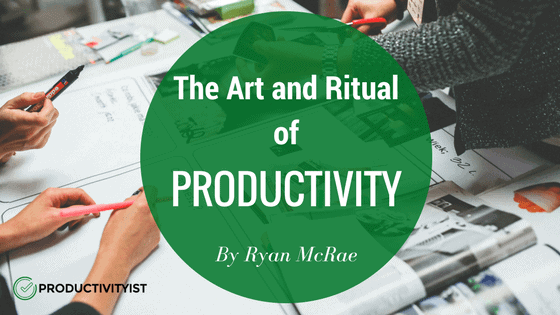
Today’s guest post is by the awesome Ryan McRae. Ryan is the founder of The ADHD Nerd, a blog dedicated to helping people with ADHD be more productive, focused and happy. He is an Apple fanatic, voracious reader, and lover of things pumpkin flavored. He can be reached at theadhdnerd@gmail.com.
When we hear the word “ritual,” a feeling of boring routine is conjured (if not some kind of spooky scene in a horror movie). But I think ritual gets a bad reputation. When it comes to productivity, having a ritual can act as a trigger in our brains and help get us into a state of flow faster.
The purpose of ritual is to simply reduce decision fatigue.
Decision fatigue occurs when we have made too many decisions, and our willpower is depleted. When our willpower is gone, we have less reserve to doing creative things—writing, making music, or cooking new dishes.
If we make our creative process more of a ritual, if we do the same things every day when we are attempting to be creative, we are more likely to have more willpower and thus more focus to do more creative work. Reduce decisions. Increase creative work. Here’s how I do it.
Same Place
I write in the same place every day. I head to the same coffeehouse and do my best to sit in the very same seat. By doing this, I don’t have to decide where to go or check reviews.
Same Music
I listen to the Arrival soundtrack when I write. Every time I cue it up, I am in front of my keyboard ready to go. I don’t listen to anything else because I want my brain to know—this is writing time. It’s an auditory signal that fires me up to write. It’s mellow music, but it changes. More importantly, it has the power to wash away the terrible coffeehouse music I endure.
Same Drink
I don’t want to try something else. I have the drink I love that is chock full of caffeine and get to writing. I don’t get anything with sugar because I don’t want to crash.
Clear My Mind
Having severe ADHD, clearing my mind is like getting all the sand out of my shoes. It takes some effort—but here’s how I do it. Before I write, I simply jot down everything that is crowding my mind. Do I need to pick up detergent? Do I have to pick my up my laundry? Did I pay my electric bill? I jot all of that down in a notebook beside me. I don’t type it because I don’t want my brain to think that my “to do” list is my creative process. I keep that very separate.
Set a Timer
I don’t want to burn out, so I simply set a timer and an alarm. The alarm is for when I’m done writing for the day. This way my brain knows there’s an endpoint to my writing. I set the timer for 50 minutes. After 50 minutes of writing, I just take a break, stand up, stretch, and get back to it after 10 minutes. I don’t want to get tired, and I don’t want to keep myself hunched over my computer for hours without some kind of stretch.
Completing the Writing Session
When I’m done writing for the day, I jot down my word count. My goal is 3,000 words in whatever form I can manage. I don’t care if it’s one long piece or if it’s a couple articles, I want to have 3,000 down. If I have 2,800, I’m busting tail the next day for 3,200 to make up the difference. And when that is finished, I simply take a minute to be grateful for the craft of writing. To be a writer, to approach and walk in the creative life for as long as I have, I recognize it as a privilege. By being grateful for it, not taking it for granted, keeps me a bit humble.
Developing Your Own Ritual
I have a buddy of mine who lights a candle when he writes (He writes from home. Coffeehouses aren’t down on that). When he feels like he’s getting distracted, the candle reminds him that his time is burning away. Another friend of mine rings a tiny gong before and after she paints. It signals the beginning and the end of her creative process.
Rituals simply train our minds to get to the business at hand, to remind us what is coming and what is accomplished. Trying a ritual for a day or two isn’t going to work any magic, but a long obedience in the same direction is what does.
What do you regularly do to “signal” your brain to start the creative process?

